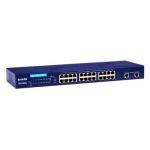Description
The HP 2620 Switch Series consists of five switches with 10/100 connectivity. The HP 2620-24 Switch is a fanless switch with quiet operation, making it ideal for deployments in open spaces. The HP 2620-24-PPoE+ Switch, HP 2620-24-PoE+ Switch, and HP 2620-48-PoE+ Switch are IEEE 802.3af- and IEEE 802.3at-compliant switches and provide up to 30 W per powered port. The HP 2620-48 Switch has variable speed fans for quiet operation. All 2620 series switches include two 10/100/1000BASE-T ports and two SFP slots for Gigabit Ethernet uplink connectivity. An optional redundant external power supply is also available to provide redundancy in the event of a power supply failure. With IPv4/IPv6 static and RIP routing, robust security and management features, free lifetime warranty, and free software updates, the HP 2620 Switch Series is a cost-effective solution for customers who are building converged enterprise edge networks.
Features
Quality of Service (QoS)
– Layer 4 prioritization: enables prioritization based on TCP/UDP port numbers
– Traffic prioritization (IEEE 802.1p): allows real-time traffic classification into eight priority levels mapped to eight queues
– Class of Service (CoS): sets the IEEE 802.1p priority tag based on IP address, IP Type of Service (ToS), Layer 3 protocol, TCP/UDP port number, source port, and DiffServ
– Rate limiting: sets per-port ingress enforced maximums and per-port, per-queue guaranteed minimums
Connectivity
– Auto-MDIX: automatically adjusts for straight-through or crossover cables on all 10/100 and 10/100/1000 ports
– IPv6: IPv6 host: allows the switches to be managed and deployed at the edge of an IPv6 network. Dual stack (IPv4/IPv6): provides a transition mechanism from IPv4 to IPv6; supports connectivity for both protocols. MLD snooping: forwards IPv6 multicast traffic to the appropriate interface; prevents IPv6 multicast traffic from flooding the network.
– IEEE 802.3af Power over Ethernet (PoE): provides up to 15.4 W per port to IEEE 802.3af-compliant PoE-powered devices such as IP phones, wireless access points, and security cameras
– IEEE 802.3at Power Over Ethernet Plus: provides up to 30 W per port to IEEE 802.3 for PoE-/PoE+-powered devices such as video IP phones, IEEE 802.11n wireless access points, and advanced pan/tilt/zoom security cameras
– Pre-standard PoE support: detects and provides power to pre-standard PoE devices; see list of supported devices in the product FAQ at www.hp.com/networking/support
Resiliency and high availability
– External redundant power supply: provides high reliability
– IEEE 802.3ad Link Aggregation Protocol (LACP) and HP port trunking: support up to 24 trunks, each with up to 8 links (ports) per trunk
– IEEE 802.1s Multiple Spanning Tree: provides high link availability in multiple VLAN environments by allowing multiple spanning trees
Manageability
– Dual flash images: provides independent primary and secondary operating system files for backup while upgrading
– Friendly port names: allow assignment of descriptive names to ports
– Find-Fix-Inform: finds and fixes common network problems automatically, then informs administrator
– Multiple configuration files: allow multiple configuration files to be stored to a flash image
– Software updates: free downloads from the Web
Layer 2 switching
– VLANs: provide support for 512 VLANs and 4,094 VLAN IDs
– Jumbo packet support: supports up to 9220-byte frame size to improve the performance of large data transfers
– IEEE 802.1v protocol VLANs: isolate select non-IPv4 protocols automatically into their own VLANs
– Layer 3 routing
– Static IP routing: provides manually configured routing; includes ECMP capability
– Routing Information Protocol (RIP): provides RIPv1 and RIPv2 routing
Security
– Access control lists (ACLs): provide IP Layer 3 filtering based on source/destination IP address/subnet and source/destination TCP/UDP port number
– Source-port filtering: allows only specified ports to communicate with each other
– RADIUS/TACACS+: eases switch management security administration by using a password authentication server
– Secure Shell: encrypts all transmitted data for secure remote CLI access over IP networks
– Secure Sockets Layer (SSL): encrypts all HTTP traffic, allowing secure access to the browser-based management GUI in the switch




